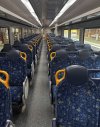Greetlander
Member
I'm British but I live in Australia. I've always been fascinated by our XPTs over here, heavily reengineered for the climate and track standards, but still recognisably a HST.
I was at the station the other day when one of our Endeavour DMU sets came past - great trains and have served NSW well, but I got to thinking that it was a relatively small fleet of single deck DMUs, top speed around 90mph. We also have Hunter Railcars, two-car DMUs and seven sets built in total.
Is there anything to stop one national rail operator from borrowing a design from another country? Would it not have been sensible for NSW to have bought into the class 158 for example? Wouldn't it be cheaper and more convenient to re-engineer an existing tried and tested design or even collaborate in the early stages?
I know nothing about engineering. Fire away.
I was at the station the other day when one of our Endeavour DMU sets came past - great trains and have served NSW well, but I got to thinking that it was a relatively small fleet of single deck DMUs, top speed around 90mph. We also have Hunter Railcars, two-car DMUs and seven sets built in total.
Is there anything to stop one national rail operator from borrowing a design from another country? Would it not have been sensible for NSW to have bought into the class 158 for example? Wouldn't it be cheaper and more convenient to re-engineer an existing tried and tested design or even collaborate in the early stages?
I know nothing about engineering. Fire away.

